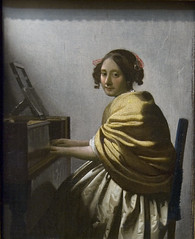The harpsichord was most probably invented in the late Middle Ages. By the 1500s, harpsichord makers in Italy were making lightweight instruments with low string tension. A different approach was taken in Flanders starting in the late 1500s, notably by the Ruckers family. Their harpsichords used a heavier construction and produced a more powerful and distinctive tone. They included the first harpsichords with two keyboards, used for transposition.
The harpsichord was widely used in Renaissance and Baroque music. During the late 18th century it gradually disappeared from the musical scene with the rise of the piano.
The piano: pressing a key on the piano's keyboard causes a felt covered hammer to strike steel strings. The hammers rebound, allowing the strings to continue vibrating at their resonant frequency.[1] These vibrations are transmitted through a bridge to a sounding board that couples the acoustic energy to the air so that it can be heard as sound. When the key is released, a damper stops the string's vibration.
The word piano is a shortened form of the word pianoforte, which is derived from the original Italian name for the instrument.
The invention of the modern piano is credited to Bartolomeo Cristofori (1655-1731) of Padua, Italy, who was employed by Prince Ferdinand de Medici as the Keeper of the Instruments. He was an expert harpsichord maker and was well acquainted with the previous body of knowledge on stringed keyboard instruments. It is not known exactly when Cristofori first built a piano. An inventory made by his employers, the Medici family, indicates the existence of a piano by the year 1700; another document of doubtful authenticity indicates a date of 1698.[citation needed] The three Cristofori pianos that survive today date from the 1720s.[5]
skip to main |
skip to sidebar
For students and parents who love education and exploration of the social sciences . . .
Search This Blog
Followers
Blog Archive
-
▼
2010
(346)
-
▼
January
(44)
- There is now abundant scientific evidence that hum...
- Americans' electricity comes from Coal, which also...
- Euro cities: Paris, Roma, London, Berlin
- Climate change / PBS.org / Frontline
- The Sunshine State: basic background on Florida's map
- Miami: America's 4th population center
- America's 4th center of population: Miami
- Amadeus review quiz
- Upfront magazine 01.18.10 - Climate change
- Indie essays
- Geography classes in lbraray next Thurs-Fri-Mon on...
- Geography class test-taking guidelines
- Requiescat in pace: Taco Bell founder Glen W Bell
- Vienna, one of the world's most liveable cities
- Guten tag!
- Guten abend! Basic phrases from the Deutsch
- Amadeus: quotes and questions
- A review of details from the movie Amadeus
- Magnet's school web site has been updated: Caddoma...
- Mozart was home-schooled and schooled on the road ...
- Mozart desired a composer's position in Vienna, ci...
- Italian composer Antonio Salieri - did he hate Moz...
- Mozart's Turkish opera: Abduction from the Seraglio
- Effervesce: geography vocab
- Vermeer painting: Young Woman Seated at a Harpsichord
- Sketch and label the neighbors of Austria
- The difference between Western Europe and Eastern ...
- Wolfgang Amadeus Mozart, 1756 - 1791, Vienna, Austria
- Semester exam: notes, old quizzes, essay background
- Vancouver to Quebec, a Canada quiz & answers
- Exam bonus points comparison essay: how to score 1...
- The Yucatan to Venezuela / the Caribbean quiz / an...
- The Greater and Lesser Antilles / quiz & answers
- Brazil, land of futbol / quiz & answers
- Tallest Building On Earth opens: Burj Dubai rename...
- Geography open notes quiz on Sept 10; call it Tres...
- Lawrence of Arabia study guide answers, numbers 62...
- A wee quiz on 3 ginormous cities & the answers
- It's the Hard-knock Life - For Us quiz & answers
- Three cacophonous cities & answers / geography quiz 5
- Water, Water, Everywhere quiz & answers / Sept 3
- Semester exam: Canada quiz answers
- Fun, fun, fun: Semester exam materials
- Semester review: the Mexico / Tenochtitlan quiz
-
▼
January
(44)

